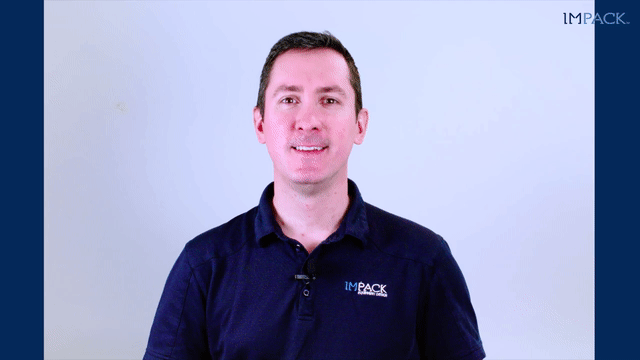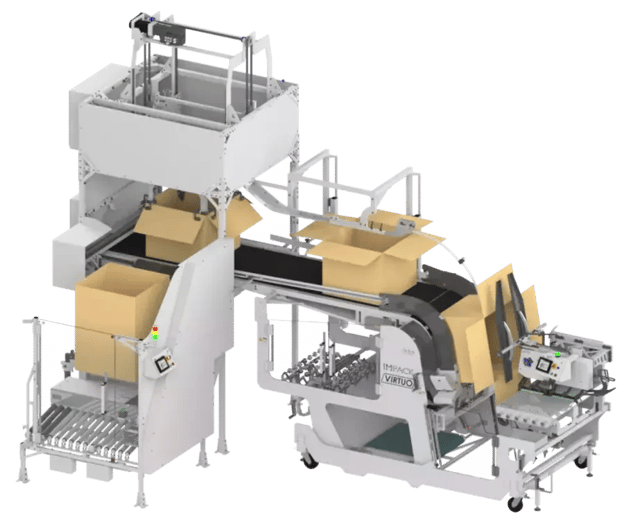Automatic Vs. Fully-Automatic Packers: Which Should You Choose? [+ VIDEO]
If you’re searching for ways to improve your folder-gluer productivity, you’ve probably noticed that some of your competitors have Semi-Automatic...
9 min read
 Mathieu Tremblay
:
August 17, 2021
Mathieu Tremblay
:
August 17, 2021
![Semi-Automatic Vs. Fully-Automatic Packers: Which Is Better? [+VIDEO]](https://impack.ca/hubfs/ezgif.com-gif-maker%20(50).jpg)
If you’re a carton box manufacturer that’s searching for ways to improve your folder-gluer’s productivity, you’ve probably come across several solutions.
Manual Packing Aid, Semi-Automatic Packers, Automatic Packers, and Fully-Automatic Packers are just some examples of the many solutions that can be installed on a folding-gluing line.
And different packaging equipment suppliers offer distinct solutions with varying features, capabilities, and levels of automation.
Of all the options on the market, how do you choose the best packer for your production?
How do you even begin to arrive at a solution? Is it simply a gut instinct?!
At IMPACK, we manufacture and install Manual, Semi-Automatic, Automatic, and Fully-Automatic folder-gluer packaging equipment and peripheral solutions.
We’re committed to teaching box manufacturers how to maximize their folder-gluer’s productivity and reach top packing speeds.
This ARTICLE + VIDEO compares Semi-Automatic packers to Fully-Automatic packers and will walk you through how to choose the best packer for your production.


First, it is important for you to know that there are 4 different levels of automation that packing systems can be categorized into:
Manual packing.
Semi-Automated packing.
Automated packing.
and Fully-Automated packing.
The manual packing process is the lowest level of automation and is usually the starting point of a folder-gluer operation. It is the traditional packing method where the entire packing process is done manually.
No automation is involved and no case management is involved.
Collecting Tables are the most common packing help/aid machine that fall under the manual packing category.
Some examples of Collecting Tables in the Western market include: Bobst’s “Handypack GT,” KBA Duran's “Omega Pack Station,” and Tünkers' “FAS 480.”
IMPACK’s Collecting Tables are the "Packing Help Stations.”
The semi-automated packing process includes at least one automated function.
For example, IMPACK’s “Ergosa packer” is one of the only semi-automatic packers that exists on the market.
It is semi-automatic because of the automated case management capabilities that it offers.
Besides our semi-automatic packer, the “Ergosa,” there are hardly any other known semi-automatic packers on the market.
IMPACK offers 2 versions of the Ergosa packer: The Ergosa A and Ergosa C.
The automated packing process is where the machine becomes the key factor of the packing process and the packing person or operator is now limited to performing background tasks such as feeding the packer with empty cases or managing full cases.
Some examples of Automatic packers in the Western market include: Bobst’s “CartonPack 4 Automatic Packer,” Heidelberg’s “Diana Packer,” WSI Global’s “Express Pack” and Graphic West Packaging’s “J-Pack.”
IMPACK’s Automatic packer is the “Virtuo.”
Of all 4 categories, the fully-automated packing process is the highest possible level of automation. The whole packing process here becomes automatically managed without requiring the presence of an operator (or any other humans) while running.
The packing person/operator is only involved in make-readies/setups.
An example of a Fully-Automatic packer in the Western market is the Bobst's "Carton Pack 4 Automatic Packer + optional case erector."
IMPACK’s Fully-Automatic packer is the “Virtuo + ACF.”
Our discussion will only focus on 2 of those 4 categories: Semi-Automatic packers versus Fully-Automatic packers.
That said, if you want a more in-depth explanation of the 4 different levels of automation, our article “What’s the Difference between Manual, Semi-Auto, Auto and Fully-Auto Folder-Gluer Packers?” digs deeper into those 4 automation levels and compares them side-by-side.

A Semi-Automatic packer partially automates your packing process.
It utilizes a modernized packing process to optimize the efficiency, ergonomy, and productivity of your case-packing process.
A semi-automatic packer includes at least one automated feature. This means that the packing person/operator of a semi-auto packer remains the key factor of the packing process but with the help of at least one auto function.
For example, with IMPACK’s Ergosa packer, this auto feature is the automated case management system.
🔍 Related: What is the Ergosa’s Case Management System & What Makes it Different from Collecting Tables?
Moving from no-automation to semi-automation brings along many benefits. One of the major advantages is that semi-automatic packers are quicker and easier to install & set up relative to fully-automatic packers.
For example, the Ergosa is the first step towards semi-automation from the traditional manual packing process that’s used with Collecting Tables. The Ergosa’s setup time is as short as 5 minutes.
Being economical, simple, and highly versatile, the Ergosa can help double your packing speed with only 1 packing person (instead of 2 packing people) thus making the packing speed per person more than 4 times faster.
🔍 Related: How Fast Can I Run With IMPACK’s Packers?
Perhaps one of the biggest selling points for a semi-auto packer is its level of flexibility.
By installing a semi-auto packer on your folder-gluer, you give your packing staff the power of easy access.
Going back to our example of the Ergosa, easy access to the boxes allows your packing staff to make adjustments, quality control checks, and corrections without ever needing to interrupt the production.
In direct contrast to Collecting Tables, the Ergosa includes case management.
Because of its high level of flexibility and easy access, the Ergosa can run quite literally anything you shoot through your folder-gluer.
In addition, you can configure the Ergosa to run different box formats based on your needs.
The Ergosa has 3 main packing modes: The “Horizontal Mode,” the “Vertical Mode” and the “Pick & Place (or Manual) Mode.”
With those 3 modes, you can run anything from small to medium boxes, straight lines, 4/6 corners, carton and corrugated boards, and multi-format boxes.
“What about Crash-lock/auto-bottom boxes?”
No problem! The Ergosa can run it in the Pick & Place Mode or in the Vertical Mode (when paired with the MFA Batch Inverter).
The best part? It is compatible with all folder-gluer models regardless of their type.
🔍 Related: What Are the Ergosa Packer’s 3 Main Packing Modes?
No machine is perfect; that’s just the reality. In some specific scenarios, semi-automation is just not the best choice.
Yes, ease-of-access and the ability to perform quality-control checks are great — if that’s something you need. However, with the power of access and the ability to make adjustments, comes the drawback of slower speed.
Another important point to consider is that you still need human supervision.
If you operate in an area where there are labor shortages or rising wages, then this option may not be worth the payback.
Learn how long it would take to get your payback from investing in a packing system.
With the demand soaring for unconventional boxes that come in various sizes, shapes, and their own inconveniences, adapting to the complex needs of the market has become more important than ever.
Depending on the types of boxes you produce and what ways you implement to increase the output of your folder-gluer, productivity can vary drastically.
“Why can’t I pack this faster?!”
That sentence represents one of the top questions we get asked here at IMPACK.
It is not a question of how reliable the folder-gluer packer is but rather a question of how you use it.
Because a semi-auto packer is highly versatile and flexible, there are so many things you can do to push your folder-gluer to its maximum potential.
But, there are also so many ways where you could be losing productivity and causing bottlenecks to your own folding-gluing lines. This is why making the most out of your semi-auto packer training is so important.

A Fully-Automatic packer offers the highest possible level of automation.
It is when you’ve automated your entire packing process so that the operator is no longer required to be present.
When it comes to comparing Collecting Tables Vs. Semi-Auto packers Vs. Fully-Auto packers, fully-auto packers are easily the more tempting option that clients want.
However, it is also the more complex option requiring digital knowledge, a larger footprint, more money, and strict emergency shutdown protocols.
That being said, for some companies, full-automation is the only realistic option.
Semi-automatic packers are far more versatile and flexible than automatic packers and there is absolutely no doubt that they are more flexible and adaptable when compared to fully-auto packers, but it is important for you to factor in the reality of your own company.
Fully-auto packers can be a perfect fit if extreme productivity is required, either because your demand is quickly increasing or because you are short of manpower.
Taking that into account, it is just as important to not overestimate your needs and end up with a packer that is too complex, too expensive, and completely not tailored to your production.
A big advantage that fully-automatic packers offer is high production speed. Let’s take our fully-auto packer “Virtuo + ACF” that is shown in the image above as an example.
The Virtuo + ACF combination is the only 100% fully-automatic folder-gluer packer that exists on the market for both corrugated and carton boards. It is the most compact and economical auto-packer to date.
If your typical production is one-row, one-layer — medium to large boxes — with an extreme focus on speed, then full-automation with the Virtuo + ACF might be the perfect fit.
The Virtuo + ACF has a speed of up to 8 cases per minute, with a high-precision laser counter, and on a small footprint.
However, if your typical production is multi-row, multi-layer case packing, then the Virtuo + ACF is not the right fit for you.
Fully-automatic packers take no breaks and no vacations. Operating 24/7, the capabilities of those machines are unmatched.
If you’re running large volumes (100,000-150,000 boxes/setup of folding cartons or 40,000 – 60,000 boxes/setup of laminated boards) with standardized boxes, then constant productivity is critical for your company.
In such situations where there is a requirement for consistency and speed, fully-auto packers are the only viable option.
Because fully-automatic packers involve a very precise and technical installation process, it is no surprise that they are more expensive as a one-time cost. Plus, they are more limited in terms of what they can do.
This is where the concept of “limitation” comes into play.
With a semi-automatic packer such as the Ergosa, you can shoot whatever box you want through your folder-gluer as you have the power of easy access and the flexibility to take out any box you want with your own hands, at any time, and place it into the case.
In contrast, when it comes to a fully-automatic packer like the Virtuo + ACF you need a larger footprint. Your fully-automatic packer has to be 100% safe. Hence, if there is ever a problem, you have to shut it down to zero with an emergency stop, otherwise, it is too dangerous for a human.
If you’re looking to produce various prints of beverage boxes that are all in the same size, then you’re happy-go-lucky with a fully-auto packer.
However, if you produce other types of boxes, then you need to put your fully-auto monster away as it is dedicated to doing that specific task and is not forgiving enough to be flexible.
On the other hand, with an Ergosa packer in Vertical Mode, you can run at relatively high speeds with crash-lock/auto-bottom boxes and only 1 human supervisor is needed.
If they see that the box is not perfect, they can easily take it out and maintain the same speed, or alternatively, they can lower the speed to control everything and then pick up the speed.
You never have to go down to zero with a semi-auto packer.
.webp?width=624&name=ezgif.com-gif-maker%20(58).webp)
A Semi-Auto packer, a Fully-Auto packer, or other options?
In some situations, a semi-automatic packer is the right choice.
In others, a fully-automatic packer is the better choice.
And sometimes, neither packers are the right fit.
It all depends on your company’s individual needs, specific circumstances, and goals.
But I won’t leave you at just that.
Here is the answer you’ve been looking for:
You want to take your first step towards improving your folder-gluer’s productivity
You’re not sure of your production and have a very tight budget
You have complex boxes that require constant adjustments/quality control checks
You have very limited floor space
If your production meets several of the characteristics described above and you’ve never had any “packing help” or “packing aid,” then a Collecting Table like IMPACK’s “Packing Help Stations” could be an excellent start.
You have variable production runs
You have small to medium-sized boxes
You have a wide and diverse variety of box formats
You have complex boxes that require constant adjustments/quality control checks
Here, IMPACK’s “Ergosa packer” could be a perfect fit.
You have long production runs
You have medium to very large-sized boxes
You have a limited variety and similar box formats
You have simpler boxes that do not need constant adjustments/quality control checks
Here, IMPACK’s “Virtuo” would be a great fit.
You have all the automatic packer requirements listed above
You want to fully automate your packing process
You want to reach a zero-human operation (no humans involved)
You're interested in advanced monitoring and industry 4.0 functionalities
Here, IMPACK’s “Virtuo + ACF” would be the best fit.
I understand that looking for the right folder-gluer packer is far from a simple task and so I hope this article helps you make a smarter decision.
Your Next Steps | Recommended Resources:
Compare Manual Vs. Semi-Auto Vs. Auto Vs. Fully-Auto Packers to discover what level of automation you should look into.
Next, compare Collecting Tables Vs. Semi-Automatic packers to determine which of those 2 packing systems are more fitting for your company.
And then, find out which of IMPACK’s 3 main packaging equipment is the right fit.
![Automatic Vs. Fully-Automatic Packers: Which Should You Choose? [+ VIDEO]](https://impack.ca/hubfs/X21-054-1.jpg)
If you’re searching for ways to improve your folder-gluer productivity, you’ve probably noticed that some of your competitors have Semi-Automatic...
![What is a Semi-Automatic Packer and How Can It Improve My Packing Process? [+ VIDEO]](https://impack.ca/hubfs/X21-057.png)
If you’re looking for ways to improve your folder-gluer’s productivity, increase your folder-gluer’s output, and reach higher speeds, you’re probably...

You and your competitors have 1 common goal: